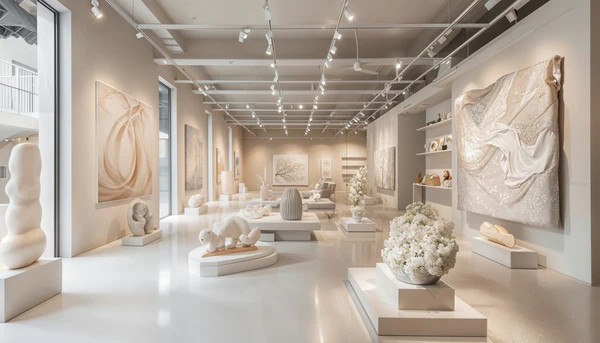Life Style
Why Acrylic Stands Are Ideal for Museum Displays
Published
2 months agoon
By
Engrnewswire
Museums are magical places where history, art, and culture come alive, inviting visitors to connect with stories from the past and present. Creating displays that captivate and inform is no small feat, but acrylic stands, acrylic standees, and acrylic pins offer a versatile, elegant solution. These glossy, durable, and customizable pieces bring a modern touch to exhibits while respecting the artifacts they showcase. With their ability to blend functionality with beauty, acrylic stands are a curator’s dream for crafting displays that feel approachable and inspiring. Here’s why they’re perfect for museum settings, told with a warm, human touch.
What are Acrylic Stands
An acrylic stand is made of lightweight acrylic that is clear or colored, transparent, and shows off items like artifacts, labels, or other small sculptures. Acrylic standees are bigger, freestanding displays great for graphic systems or replicas, while acrylic pins are smaller accents that can be used in interactive exhibits to add some flair. They’re sleek and shiny, and yet they reflect the light just right, providing a cool, modern look that does not overshadow the artifacts themselves. They are also sturdy and easy to clean, and come with many customization options, making them a sensible choice for all sizes of museums.
What makes them special? They enhance without stealing the spotlight. In a museum, where every piece has a story, acrylic stands act like quiet storytellers, supporting the narrative while letting the artifacts shine. Let’s explore how they elevate museum displays.
1. Create Engaging Informational Displays
Every artifact needs context, and an acrylic standee is perfect for sharing those stories. A standee with a printed label or graphic can sit beside an exhibit, offering details about its history or significance. For instance, an acrylic standee next to a dinosaur fossil could feature a timeline of the creature’s era, printed in crisp, vibrant colors that catch the eye without overwhelming the space.
These standees are also great for temporary exhibits. Their lightweight nature makes them easy to move or swap out, and their durability ensures they hold up through months of use. A natural history museum might use an acrylic standee shaped like a leaf to introduce a botany exhibit, blending form and function in a way that feels inviting.
2. Add Interactive Elements with Acrylic Pins
Museums are increasingly interactive, and acrylic pins can add a playful, tactile element. These small, colorful pieces can be used in hands-on displays or as take-home keepsakes. For example, a children’s museum could create a station where visitors pin acrylic pins shaped like animals onto a map, learning about habitats while engaging with the exhibit.
Alternatively, pins can be displayed as part of an exhibit. A small grid of acrylic pins showcasing different historical figures or symbols can be mounted on a wall, encouraging visitors to lean in and explore. Their compact size makes them ideal for adding detail without cluttering the space, and their vibrant designs can tie into the exhibit’s theme.
3. Highlight Artifacts with Subtle Elegance
Museums require displays that let the art and artifacts, not the installation, shine. Acrylic stands are great here because of their transparency and low-profile look. A delicate pottery shard or small sculpture is the object you never knew you wanted. They may look like they’re floating, but they are supported by a clear acrylic stand. This transparency allows the emphasis to be kept on the object and offers solid support. For instance, an ancient coin would be propped up by a little acrylic standee in such a way that it faced visitors, its details uninterrupted by distracting elements.
The glossy finish of acrylic adds a touch of sophistication, making even simple displays feel polished. Museums can customize stands to fit specific artifacts—whether it’s a curved base for a vase or a tiered stand for a collection of jewelry—ensuring each piece is presented with care and respect.
4. Ensure Durability for Long-Term Exhibits
Museum displays need to withstand time, foot traffic, and curious hands. Acrylic stands are tough, resisting scratches and wear better than many materials. Unlike wood or metal, acrylic doesn’t rust or warp, making it ideal for humid or temperature-controlled environments like galleries. An acrylic standee holding a heavy artifact or a frequently handled interactive display will stay looking fresh for years.
This durability also means less maintenance. A quick wipe with a soft cloth keeps acrylic looking pristine, which is a lifesaver for busy museum staff. Whether it’s an acrylic stand supporting a delicate textile or a pin display in a high-traffic area, these pieces are built to last.
5. Customize for Thematic Cohesion
Every museum has a unique vibe, and acrylic stands can be tailored to match. A modern art museum might opt for sleek, clear acrylic standees with minimalist text, while a cultural history museum could choose stands with warm, earthy tones to complement traditional artifacts. Customization options are nearly endless—shapes, sizes, colors, and even printed designs can align with an exhibit’s theme.
For example, a maritime museum could use acrylic standees shaped like waves to display ship models, tying the display to the ocean theme. Acrylic pins could feature tiny anchors or shells, sold in the gift shop or used in interactive displays, creating a cohesive experience that feels thoughtful and immersive.
Final Thoughts
Acrylic stands, acrylic standees, and acrylic pins are more than display tools — they’re a means of making museum shows feel alive and approachable. From artfully spotlighting showpieces to incorporating playful touches, these as-the-eye-can-reach accents emphasize both form and function. They’re sturdy for long-term use, can be customized to match any theme, and are accessible to visitors of all abilities. With the addition of acrylic stands, museums can aim to create exhibits that not only reflect the past but also bring joy and connection to everyone who walks through the door. So, the next time you’re curating an exhibit, think about these malleable pieces — maybe they will be the finishing touch you were looking for.
You may like

Top Ikea Hacks to Transform Your Home Efficiently

Unique Ways to Immerse Yourself in Local Culture While Travelling

Importance of Three Ashras of Ramadan in Islam

How Local Couriers Support Small Businesses

Best Replica YSL Bag in Patent Leather

Put Pen to Paper: How Custom Notebooks Can Make a Lasting Impression

From Listing to Sold: Sell A Car in Perth Without the Stress

Unlocking the Benefits of Engineered Steel Solutions for Modern Construction

Discover the Ultimate Comfort and Style of Women’s Underwear in Australia

Unlocking Performance: The Ultimate Guide to Custom PC Builds with Centre Com

Carol Kirkwood’s Journey: Her Real Age, Husband, Career, and More

Revolutionizing Healthcare: The Emergence of AI-Driven Analytics

How Machine Learning and AI are Redefining the Future?

Aliza Barber: Meet Lance Barber’s Wife, Age, Life, Profile, Career and Net Worth

Evelyn Melendez: Jordan Knight’s Wife Bio, Marriage, Family, Career and Net Worth

Ilan Tobianah Biography: Family, Marriage, Lifestyle, Career and Net Worth

Who was Alice Marrow? Everything to Know About Ice-T’s and His Mother

King Von’s Autopsy Report: The Truth Behind the Tragic Death

Meet Otelia Cox: The Supportive Wife of Tony Cox – A True Fairy Tale Romance

Tea Leoni and Tim Daly Split – A Closer Look at Their Relationship and Breakup

Top Ikea Hacks to Transform Your Home Efficiently

Unique Ways to Immerse Yourself in Local Culture While Travelling

Importance of Three Ashras of Ramadan in Islam

How Local Couriers Support Small Businesses

Best Replica YSL Bag in Patent Leather

Put Pen to Paper: How Custom Notebooks Can Make a Lasting Impression

From Listing to Sold: Sell A Car in Perth Without the Stress

Unlocking the Benefits of Engineered Steel Solutions for Modern Construction

Discover the Ultimate Comfort and Style of Women’s Underwear in Australia

Unlocking Performance: The Ultimate Guide to Custom PC Builds with Centre Com
Category
Trending
-

 News2 months ago
News2 months agoCarol Kirkwood’s Journey: Her Real Age, Husband, Career, and More
-

 Health2 years ago
Health2 years agoRevolutionizing Healthcare: The Emergence of AI-Driven Analytics
-

 Technology2 years ago
Technology2 years agoHow Machine Learning and AI are Redefining the Future?
-

 Celebrity1 year ago
Celebrity1 year agoAliza Barber: Meet Lance Barber’s Wife, Age, Life, Profile, Career and Net Worth
